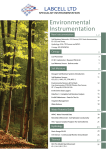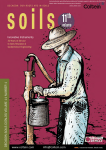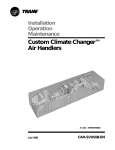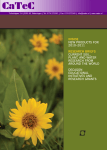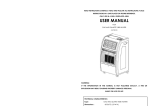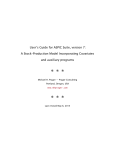Download Heat Pulse 2011 - manuals.decagon.com
Transcript
HeatPulse 2011 E X P LO R I N G T H E R M A L P R O P E RT I E S M E A S U R E M E N T OF N AT U R A L & E N G I N E E R E D M AT E R I A L S Thermal Dryout Curves: How and Why D r. Gaylon Campbell has been measuring the thermal properties of soil for quite a few years. Occasionally he’ll get a call from someone asking him to tell them the thermal conductivity or resistivity of their particular soil. “I’m always a little flummoxed by that question,” he says. “It’s like calling to ask me what the temperature is outside your house. I’m going to guess that it’s somewhere between -25˚C and 38˚C. If you give me additional information, I might get closer, but there’s no magic number for the temperature of the air.” No Golden Number Similarly, there is no “golden” thermal conductivity/resistivity number for soil. Four things significantly affect a specific soil’s thermal conductivity/resistivity: its composition, its temperature, its bulk density, and its water content. There are only two ways to know the thermal conductivity/resistivity of a specific soil sample: you can compute it using a tested model or you can measure it directly. News from Decagon Devices about thermal properties. continued on page 2 ¬ www.thermalresitivity.com Fire & Ice: Heat Flow in Snow W hen Wired Magazine wrote up Dr. Ed Adams and his colleagues in February 2011, they didn’t refer to them as a team of civil engineers studying granular mechanics. Instead, they named them one of seven teams of “Mad Scientists” and called them “Snow Bombers.” It’s not hard to find articles about Montana State University’s avalanche studies program. Just describing a typical field study makes for a good story: to investigate real-world avalanche conditions, MSU researchers sit in an outhouse-sized shack bolted to the side of a mountain while colleagues trigger an avalanche up-slope. continued on page 7 ¬ Thermal Dryout Curves: How and Why continued from cover 11 Sand G (Liguid Return Flow) 0.8 0.8 Conductivity Varies with Water Content 0.6 0.6 It’s important to understand how thermal conductivity/ 0.4 0.4 resistivity measurements are 0.2 affected by changing 0.2 conditions. Temperature, density, 00 and mineralogy are 0 0 often relatively constant in a specific soil, but water content is highly variable. That variability can have a significant effect on thermal conductivity. To understand these effects in a specific soil, it’s often useful to develop a dryout curve—a graph showing how thermal conductivity varies with changes in water content in that particular soil. Effect of Latent Heat Figure 1 shows dryout curves for several different soil types at 25˚C. The dramatic jump in the curves at intermediate water contents indicates the start of an important but often overlooked component of heat movement in soils: latent heat transfer. Under certain conditions, soil transports latent heat by acting as a natural heat pipe. How Heat Pipes Work A heat pipe uses liquid in an evaporation-condensation cycle to Figure 1 Thermal Dryout curve Loam Clay 0.1 0.10 0.2 0.20 water content (m 3/m 3) conduct heat between two solid interfaces. At the hot interface, the liquid absorbs heat and evaporates. It moves as a vapor from the hot interface to the cold interface, where it condenses back into a liquid and releases latent heat. The liquid then returns to the hot interface where it evaporates and repeats the cycle. Soil: A Natural Heat Pipe At intermediate water contents, each soil pore acts as a natural heat pipe. Water evaporates at the hotter side, diffuses across the pore, and then condenses on the cooler side. In order for the process to work properly, water has to be conducted back in the liquid phase to the hotter side of the pore to reevaporate. continued on page 4 ¬ FOR A COPY OF THE DETAILED APPLICATION NOTE, VISIT WWW.DECAGON.COM/DRYOUT OR CALL 1-800-755-2751 2 0.3 0.30 0.4 0.40 IS THERE A DIFFERENCE? I n buried power applications, the term “thermal resistivity” is typically used instead of thermal conductivity. Thermal resistivity is the inverse of thermal conductivity, and in fact, most people see the difference between the two as purely semantic. But there are some potential pitfalls for the uninitiated and serious mathematical errors can be made by using thermal resistivity values in models without thinking. We use thermal conductivity in these models because: 0.5 1 2 3 Thermal conductivity has a normal statistical distribution. Resistivity doesn’t. So if we’re computing an average, an average conductivity would be a meaningful number. An average resistivity might not. When interpolating over water contents, conductivity is more linear with water content than resistivity is. Conductivity gives a more correct perception of the significance of the numbers, because it’s directly proportional to heat flow, which is the thing we’re most interested in. To give an extreme example, assume two materials of equal area, one with a conductivity of 1 and one with a conductivity of 0. Averaging the conductivities would give 1/2. Averaging the resistivities would give infinity. When we calculate the heat flow, thermal conductivity would correctly predict an average heat flow of 1/2. Thermal resistivity predicts zero heat flow. Principles discussed in this article apply to resistivity, but care should be taken in working with resistivity numbers. www.thermalresitivity.com 3 Four things significantly affect a specific soil’s thermal conductivity/resistivity: its composition, its temperature, its bulk density, and its water content. continued from page 2 Hydraulic Conductivity The hydraulic conductivity of the soil affects the liquid return flow that’s required for the water to evaporate again and carry the latent heat with it. As you can see in Figure 1, liquid return flow cuts off at a lower water content in sandy soil. For a clay with more particle surface area, the cutoff is at a higher water content. Methods for Constructing Curves Because soil composition varies significantly, a dryout curve should be made for each different soil type you are evaluating. There are www.thermalresitivity.com 4 several methods that can be used to construct dryout curves. Single Sample- Method One The most accurate method involves collecting a single soil sample and measuring its thermal conductivity and water content as it dries down from saturation to oven dry. This method is generally considered the best, but is time and effort intensive. Multi-Sample- Method Two The alternative to this method involves taking a large soil sample and mixing it to different moisture contents. The samples are packed Thermal conductivity (W/mK) Figure 2 Volumetric Water Content (m3/m3) to the appropriate bulk density and analyzed for thermal conductivity and moisture content. This method is frequently used because it’s fast and convenient, but it lacks the accuracy of the single sample method. It’s difficult to get good readings on dry samples because you can’t pack them to a high enough bulk density. Better Approach Over the past year, we’ve worked to develop a method that has the best of both worlds—the accuracy of a single sample method with the speed and convenience of the multisample method. The method we propose is detailed in an application note available at www.decagon.com “Producing Thermal Dryout Curves for Buried Cable Applications”. Interpolated CurveBest Method Simply put, it involves taking measurements at just two points on the dryout curve, and then uses a model to interpolate the curve. Figure 2 shows the agreement of the model with actual collected data. As you can see, the model is consistent with data gathered using the single sample method and shows the inaccuracies inherent in the multi-sample method. 5 Fire & Ice: Heat Flow in Snow 6 www.thermalresitivity.com HEAT FLOW IN SNOW continued from cover But this isn’t just a story about explosions and extreme sports. At its heart, it’s a story about the microstructure of a very fascinating and difficult material. Rich Shertzer, who is just finishing a PhD at Montana State, thinks snow may be unique among natural materials because “the thermal environment it’s exposed to every day can cause pretty remarkable changes in its microstructure.” A cold, sunny day in the mountains can cause significant changes in snow crystals. It can change their size and shape, but more significantly it can cause a directional orientation in snow layers. It’s long been empirically understood that avalanches tend to form above “weak layers” of snow. Shertzer and his colleagues are studying how the orientation of snow crystals correlates with weak layers. Most models of granular mechanics assume that the material’s microstructure is randomly arranged. However, snow layers seem to show a regular arrangement. As Shertzer explains, “qualitatively, people have known for a while that when you look at certain snow layers, chains of these ice grains seem to be forming. What I was trying to mathematically model is how that might affect the material properties [of snow], including thermal properties.” In order to study the thermal properties of snow samples, the research team wanted a way to measure thermal conductivity in three directions. That ruled out flux plates. Thermal probes were an continued on page 8 ¬ READ MORE ABOUT SNOW RESEARCH AT THE UNIVERSITY OF MONTANA, VISIT WWW.DECAGON.COM/MONTANASTATE 7 “THE ORIENTATION OF THE CHAINS FOLLOWS A DIRECTION OF INCREASED CONDUCTIVITY, AND THE DIRECTIONS THAT ARE PERPENDICULAR TO THE CHAINS TEND TO DECREASE IN CONDUCTIVITY.” continued from page 7 obvious alternative, but they brought a different set of challenges. Snow has a very low thermal conductivity, and as Shertzer explains, “if you add a lot of thermal energy to snow, since it’s very insulative, you’ll tend to raise the temperature. Not only do we want to avoid melting the snow in the neighborhood of the probe, but we want to prevent the probe from artificially inducing the same thermal processes we’re measuring—the ones that cause the crystals to change size, and shape, and orientation.” Unbeknownst to him, Decagon’s research scientists had just completed a year-long project focused on reducing the contact resistance errors that occur when using the large TR1 needle to measure thermal conductivity in large-grained samples. This made the TR-1 needle a good candidate for measuring thermal conductivity in snow. The scientists were excited about modifying KD2 Pro firmware to produce a low power version that would work in snow. The resulting modification has given Shertzer some good data. Shertzer read an article about measuring thermal conductivity in liquids, where if you add too much “I can definitely say that the anisotropy is there [in the snow samples]. It’s measureable and it’s significant. As the crystals reorient in these dept hoar like chains, the ice network is more conductive than the air in between. The increased conductivity follows the direction of the oriented chains, and the directions that are perpendicular to the chains tend to decrease in conductivity. Qualitatively, it’s always made sense, and we were just looking for a way to actually relate it to measurable properties like conductivity. We expect that this orientation also affects other properties like strength and stiffness, which will hopefully bring us back to failure and avalanches.” heat, you induce convection. “Our situation is similar to that,” he explains. “Heating the needle induces local phase change.” The article gave him some ideas about delivering low levels of heat for a relatively long period of time, and he contacted Decagon to see if that option was a possibility. TR-1 Sensor 10cm needle length Thermal conductivity or thermal resistivity of soil or porous materials. ASTM and IEEE compliant. 8 www.thermalresitivity.com NEW KD2 PRO POWER MODE FUNCTION O ne of the most significant challenges in measuring the thermal properties of snow is that the contact resistance between the probe and the snow strongly influences the reading. Last year’s firmware changes for the TR-1 needle created opportunities to try the KD2 Pro in snow, but the TR-1 needle was originally intended for rock and soil, so it had too much heat for snow applications. In order to help Dr. Adams’s research team, Decagon scientists created a new, low power option for the TR-1 needle. It has a very low temperature rise to avoid melting and vapor transport in the snow, while still accessing the firmware changes that minimize contact resistance errors. Originally this change was programmed into a single unit, but Decagon has now made Power Mode a standard feature on all units. A few points to consider: KS-1 in low power (the default) mode is the best needle for liquids. DON’T use high power mode with liquids. It will cause free convection and compromise your measurements. (See Chapter 6 of the KD2 Pro Manual for more information on measuring thermal conductivity in liquids.) DON’T make measurements in low-viscosity fluids with the SH-1 (dual needle) sensor in either high or low power mode. Do You Need Power Mode? We want to let you know that this option exists, but most users should keep using the default. In all but a few cases, changing the Power Mode will reduce accuracy. You should only change the defaults if you clearly understand how your readings will be affected. It may be a good idea to talk to a scientist at Decagon to discuss specifics. Measuring thermal properties in frozen materials? In this case, we do recommend using the TR-1 set to low power (non-default) mode. The TR-1 needle will reduce contact resistance errors, and the decreased heat input is less likely to cause phase change (melting) in the sample. The Power Mode is accessed in the Config menu. Find the latest firmware and updated User’s Manual at decagon.com/kd2pro. 9 Can the KD2 Pro be used to measure soils with a lot of larger aggregate? B ecause the TR-1 needle approximates an infinitely small diameter and infinitely long heat source, in theory, the sensor can calculate thermal conductivity/resistivity on most solid materials. However, there are limitations as to the particle size of the aggregate that it can accurately measure. The KD2 Pro with the TR-1 needle can accurately measure the thermal conductivity/ resistivity of particles as large as coarse sand (1 mm diameter). Larger materials can cause problems for the TR-1 needle, especially if they are dry. Problems include the air gaps between the aggregate which cause contact resistance errors, and the presence of a single object (not representative of the overall material, e.g. stones) located next to the thermistor in the middle of the needle. Adhere to the following suggestions to improve accuracy in large aggregate materials: 10 Reduce contact resistance errors (air gaps, unrepresentative objects next to needle). Ensure thermal equilibrium between needle, material, and air before a measurement. Verify that the needle insertion site is representative of the overall material. Conduct multiple measurements to check for sample variability. Establish and adhere to standardized testing procedures. We recommend a written protocol with a minimum of three readings in three different areas of the sample. Large aggregates may require a different method (e.g. a steady state device). If the sample has a rogue stone in the material, carefully analyze the data to see if it is influencing the readings. There is also a danger of layering in the sample and thus the thermistor may read one layer of the material that again may not be representative of the whole. When testing for thermal conductivity/ resistivity, we should always be mindful of what could be impacting our readings. Following a standard testing protocol, knowing the limitations of our instrumentation, and adhering to a few measurement principles can greatly improve the accuracy of the data we report. A standard testing protocol improves the accuracy of the KD2 Pro. The KD2 Pro with the TR-1 needle can accurately measure the thermal conductivity/resistivity of particles as large as coarse sand (1 mm diameter). www.thermalresitivity.com 11 HeatPulse 2011 2365 NE Hopkins Court Pullman, Washington 99163 www.decagon.com www.thermalresitivity.com [email protected] 509-332-2756 ◊ RENT ME Ask about our KD2 Pro rental program. Email [email protected] HeatPulse 2011 E X P LO R I N G T H E R M A L P R O P E RT I E S M E A S U R E M E N T OF N AT U R A L & E N G I N E E R E D M AT E R I A L S













